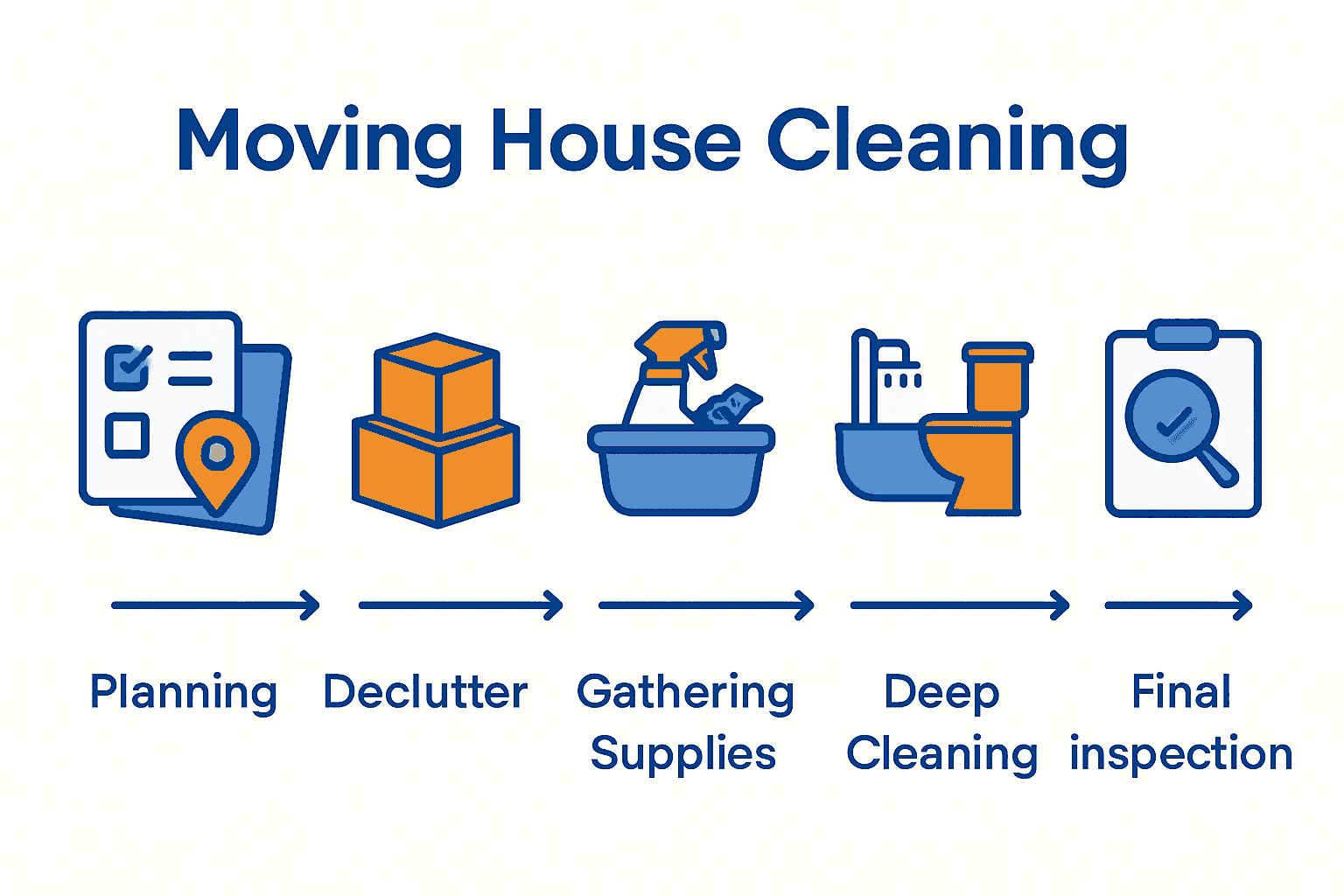Did you know that over 60 percent of renters lose part of their deposit due to cleaning issues during a move? Cleaning your home before moving out matters far more than most people realize. A well-structured cleaning plan not only saves time but can also spare you from costly penalties and stressful surprises. With the right approach, tackling each room becomes much easier and sets you up for a smoother transition to your new home.
| Key Point | Explanation |
|---|---|
| 1. Clean room by room | Break down cleaning tasks by room to make the process more manageable and less overwhelming. |
| 2. Declutter before packing | Sort items into keep, donate, and discard piles to lighten your load and simplify moving. |
| 3. Gather essential cleaning supplies | Assemble a portable cleaning kit with all-purpose cleaners, cloths, and tools to streamline your cleaning process. |
| 4. Deep clean high-traffic areas | Focus on kitchens and bathrooms first, ensuring thorough cleaning of frequently used surfaces to prevent buildup of dirt. |
| 5. Inspect and finalize cleaning | Conduct a detailed final check to catch missed spots and ensure the property is left in pristine condition. |

Moving house requires a systematic cleaning approach that transforms what could be an overwhelming task into a manageable project. According to East Riding Council guidance, breaking down cleaning into room-specific chunks helps make the process less daunting and more achievable.
Start by creating a room-by-room cleaning map. Walk through your property and mentally divide each space into distinct zones. For bedrooms, focus on surfaces like wardrobes and windowsills. In kitchens, prioritise worktops, appliances, and inside cupboards. Bathrooms need special attention to sanitary ware and tiles.
Here’s a summary of key cleaning priorities for each main room:
| Room | Main Cleaning Focus | Common Tasks |
|---|---|---|
| Bedroom | Dust and declutter | Clean wardrobes Wipe windowsills Hoover floors |
| Kitchen | Sanitise and degrease | Clean worktops Appliances inside/out Cupboards |
| Bathroom | Disinfect and remove limescale | Scrub sanitary ware Clean tiles Polish fixtures |
| Living Areas | Surface clean and tidy up | Dust furniture Vacuum floors Wipe switches |
As Mid Devon Council recommends, work from top to bottom in each room. Begin with high surfaces like shelves and light fixtures, then progress downwards to worktops, furniture, and finally floors. This prevents dust and debris from falling onto already cleaned areas.
Consider time-based cleaning targets. The East Riding Council suggests breaking tasks into 10-minute bursts. Set a timer and focus intensely on one specific area. You will be surprised how much you can accomplish in short, focused intervals.
Pro tip: Gather all cleaning supplies before starting. A caddy with multi-purpose cleaners, microfibre cloths, and bin bags will keep you efficient and prevent unnecessary trips back and forth.
By systematically approaching your cleaning, you transform a potentially stressful task into an organized, methodical process. Your next step? Grab those cleaning supplies and start tackling one room at a time.
Moving house presents the perfect opportunity to streamline your belongings and lighten your load. As North East Lincolnshire Council advises, a thorough clear-out before packing can significantly simplify your moving process and reduce unnecessary work.
Start by creating three distinct sorting piles: keep, donate, and discard. Walk through each room with large bin bags or boxes, making quick decisions about every item. Be ruthless. If you have not used something in the past year and it does not hold significant sentimental value, consider letting it go.
Wealden District Council emphasises the importance of clearing out all spaces completely particularly hidden areas like lofts and storage spaces. Pull everything out and assess each item critically. Old paperwork, outdated electronics, and forgotten household items are prime candidates for removal.
For sentimental items you struggle to part with, consider taking digital photographs to preserve memories while reducing physical clutter. This approach helps you keep the emotional connection without maintaining physical storage.
Pro tip: Schedule your decluttering over several days. Attempting to do everything in one marathon session can lead to decision fatigue and less effective sorting. Tackle one room or even one cupboard at a time to maintain focus and motivation.
Remember that decluttering is not just about reducing volume. It is about creating space for new experiences and simplifying your life. By clearing out unwanted items now, you are setting yourself up for a smoother moving process and a more organised new home.

Preparing for a thorough house move requires having the right cleaning arsenal at your disposal. According to East Riding Council, selecting versatile tools and trusted cleaning products can dramatically simplify your cleaning process.
Start by investing in a comprehensive cleaning kit. Prioritise multipurpose cleaners that work across different surfaces. Microfibre cloths, extendable cleaning tools, and a sturdy cleaning caddy will be your best companions. Look for long-handled tools that reduce physical strain and make reaching difficult areas easier.
Wealden District Council emphasises the importance of having specialised cleaners for specific areas. For kitchen surfaces, gather degreasers and antibacterial sprays. Bathroom fixtures require limescale removers and tile cleaners. Glass surfaces demand streak-free cleaning solutions.
Consider creating a portable cleaning kit with essential items: all-purpose cleaner, glass cleaner, disinfectant wipes, scrub brushes, sponges, rubber gloves, bin bags, and paper towels. Pack these in a sturdy container that you can easily carry from room to room.
Pro tip: Choose concentrated cleaning products that can be diluted. This approach saves money, reduces plastic waste, and ensures you have enough product to complete your entire moving clean-out.
By preparing your cleaning supplies in advance, you transform what could be an overwhelming task into a systematic and manageable process.
Your next step is to start applying these tools strategically throughout your home.
Deep cleaning your home requires strategic focus on areas that accumulate the most dirt and wear. As East Riding Council advises, breaking down cleaning tasks and concentrating on frequently used spaces ensures no critical zone gets overlooked.
Start with your kitchen and bathroom. These high-traffic zones demand meticulous attention. In the kitchen, scrub worktops, inside cupboards, behind appliances, and underneath the sink. Pay special attention to areas where grease and food residue collect. Use degreasers and antibacterial sprays to tackle stubborn grime.
Wealden District Council emphasises thoroughly cleaning bathroom fixtures. Tackle tiles, grout, shower screens, and sanitary ware. Use limescale removers for taps and shower heads. Disinfect toilet areas completely. Do not forget often missed spots like baseboards, door handles, and light switches.
Move to other high-traffic areas like entryways, hallways, and living room floors. These spaces collect significant dirt from daily movement. Use a systematic approach cleaning from top to bottom. Wipe down walls, clean skirting boards, and vacuum or mop floors thoroughly.
Pro tip: Work in sections and use clean cloths for different areas to prevent cross-contamination. Change your cleaning water frequently to ensure you are actually cleaning rather than spreading dirt around.
By methodically addressing these key zones, you ensure a comprehensive clean that goes beyond surface-level tidying. Your next step is to focus on those final detailed touches that transform a clean space into a pristine one.
The final stage of moving house cleaning is a critical checkpoint that can save you potential financial and logistical headaches. As Mid Devon Council warns, failing to thoroughly clean and inspect your property could result in unexpected charges for cleaning and clearance.
Start by stepping back and viewing each room with fresh eyes. Use natural daylight to help spot missed areas. Check corners, skirting boards, windowsills, and less obvious spaces like behind doors and underneath furniture. Pay particular attention to areas that accumulate dust and grime unnoticed.
Wealden District Council emphasises the importance of removing all rubbish and ensuring no alterations remain. Walk through each room methodically with a critical eye. Use a white cloth to test surfaces for residual dirt. Wipe down light switches, door handles, and other frequently touched surfaces that might have been overlooked during initial cleaning.
Focus on problem areas that typically require extra attention. Check kitchen appliances inside and out. Ensure bathroom fixtures gleam and tiles are free from soap scum. Vacuum or mop floors with a final pass, looking for any remaining marks or debris.
Pro tip: Take photographs of each cleaned room. These serve as personal documentation and can provide evidence of the property’s condition if needed for future reference or potential disputes.
By performing a thorough final inspection, you transform a standard clean into a professional level of preparation. Your meticulousness now will ensure a smooth transition and potentially protect you from unexpected cleaning charges when moving out.
Moving house can be overwhelming, especially when you face the challenge of deep cleaning, decluttering and organising every room before your big day. This article highlights the importance of a well-planned cleaning strategy and offers practical tips to tackle high-traffic zones and final touch-ups. You want a smooth transition without last-minute stress or unexpected cleaning charges. That is where professional help makes all the difference.

Trust Schott Removals to take the weight off your shoulders with over 30 years of experience dedicated to delivering a reliable and stress-free moving service. Whether you need efficient local or national removals, expert packing, or secure storage solutions, our family-run company combines professionalism with personalised care. Discover how other satisfied customers have benefited from our support in the Testimonials Archives – Schott Removals. Don’t let cleaning worries hold you back. Visit Schott Removals now to get a quick online quote and start your smooth move today before slots fill up. For insights beyond moving and cleaning, explore our Uncategorised Archives – Schott Removals for helpful tips and guides.
To effectively plan your cleaning strategy, create a room-by-room cleaning map. Walk through your property to identify distinct zones in each room and focus on specific cleaning tasks like dusting, sanitising, and decluttering.
To declutter efficiently, create three sorting piles: keep, donate, and discard. Evaluate each item quickly; if you haven’t used something in over a year, consider parting with it to lighten your load and simplify packing.
Gather a comprehensive cleaning kit that includes multipurpose cleaners, microfibre cloths, and specialized cleaners for specific areas like the kitchen and bathroom. Make sure to pack a portable cleaning caddy to keep all your cleaning essentials organized and easily accessible.
Focus on deep cleaning high-traffic zones like the kitchen and bathroom by scrubbing worktops, fixtures, and floors meticulously. Work methodically from top to bottom, ensuring to tackle often-missed spots such as behind appliances and under sinks.
After cleaning, perform a thorough inspection of each room to ensure no areas are overlooked. Look for residual dirt in corners and on surfaces, and clean any problem areas like kitchen appliances and bathroom fixtures before finalising your move.
To avoid unexpected cleaning charges, conduct a detailed final inspection of your property, checking all surfaces and frequently touched areas. Taking photographs of each cleaned room can also serve as documentation of the property’s condition for future reference.
Unit 20, Lingfield Point
McMullen Road,
Darlington
DL1 1RW
Telephone: 01325 487091
Email: info@schottremovals.co.uk